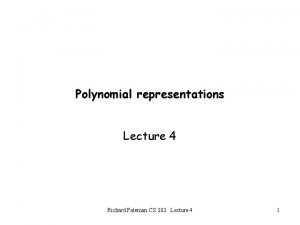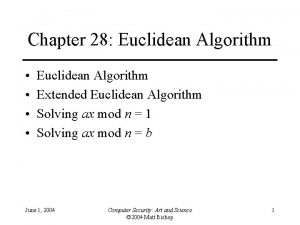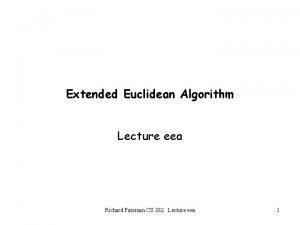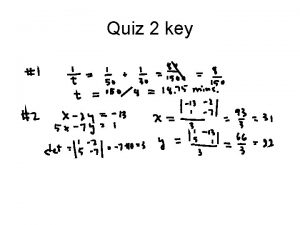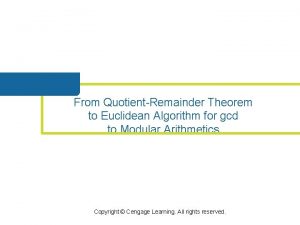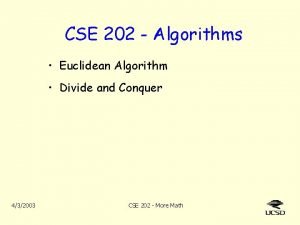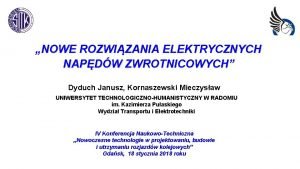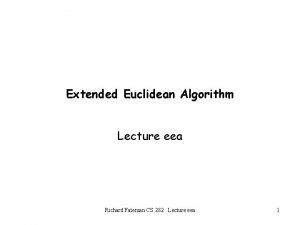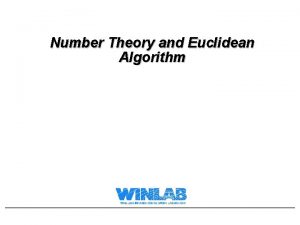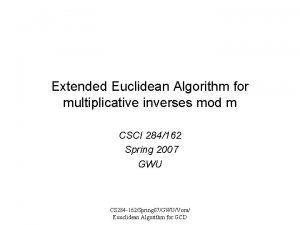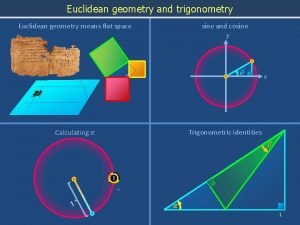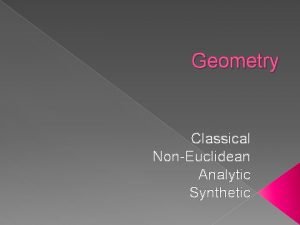Extended Euclidean Algorithm Lecture eea Richard Fateman CS









- Slides: 9

Extended Euclidean Algorithm Lecture eea Richard Fateman CS 282 Lecture eea 1

The EEA solves A¢ P + B¢ Q = G Given integers P and Q. Determine A, B, G such that G=gcd(A, B) A¢ P + B¢ Q = G Where uniqueness is asserted by deciding on |A|<|Q|, |B|<|P|, and G is the (positive) GCD. . 1*39 -1*26= 13 because gcd(39, 26)=13. 13*25 -9*36=1 because gcd(25, 36)=1. Richard Fateman CS 282 Lecture eea 2

The EEA finds inverses mod Q from A¢ P + B¢ Q = G Assume Q is a prime integer, and P ≠ Q. Determine A, B such that A¢ P + B¢ Q = 1. (gcd(P, Q)=1 ) Where uniqueness requires 0<A<Q-1, or |A|<(Q-1)/2 If we do all our arithmetic modulo Q, then Q 0 And so A*P=1 mod Q. Thus A is the inverse of P mod Q. Example: (-5)*5 +2*13=1, so -5 is the inverse of 5 mod 13. -5 8 mod 13… Richard Fateman CS 282 Lecture eea 3

The EEA solves A¢ P + B¢ Q = G, polynomials Given polynomials (coefficient field? ? ) P and Q. Determine A, B, G such that G=gcd(A, B) A¢ P + B¢ Q = G Where uniqueness is asserted by deciding on a main variable x, with respect to which deg(A)<deg(Q), deg(B)<deg(P), and G is in some normal form. For example, over rationals, we would insist that G be unit normal. E. g. if it were an integer, G would be 1. Richard Fateman CS 282 Lecture eea 4

The EEA solves A¢ P + B¢ Q = G For Knuth’s polynomials we would like … P=x 8+x 6 -3*x 4 -3*x 3+8*x 2+2*x-5, Q=3*x 6+5*x 4 -4*x 2 -9*x+21, A=(13989*x 5+18450*x 4+40562*x 3+67125*x 2+5149*x 9737)/130354 B=-(4663*x 7+6150*x 6+10412*x 5+18275*x 4 -9888*x 321579*x 2 -3820*x-3889)/130354 G=1 Richard Fateman CS 282 Lecture eea 5

The EEA algorithm (in Macsyma) extended_gcd(u, v, x): = block([u 1, u 2, u 3, v 1, v 2, v 3, t 1, t 2, t 3], u: rat(u, x), v: rat(v, x), [u 1, u 2, u 3]: [rat(1), rat(0), u], [v 1, v 2, v 3]: [rat(0), rat(1), v], while v 3#0 do (q: quotient(u 3, v 3, x), [t 1, t 2, t 3]: [u 1, u 2, u 3]-q*[v 1, v 2, v 3], [u 1, u 2, u 3]: [v 1, v 2, v 3], [v 1, v 2, v 3]: [t 1, t 2, t 3]), [u 1, u 2, u 3]) Richard Fateman CS 282 Lecture eea 6

The EEA algorithm (in Macsyma) Actually, we lied, and the GCD instead of being 1 comes out as -1288744821/543589225. We have to make a correction here. . Richard Fateman CS 282 Lecture eea 7

The EEA algorithm, reducing the result eea(u, v, x): = /* smallest gcd */ block([u 1, u 2, u 3, v 1, v 2, v 3, t 1, t 2, t 3, realgcd: gcd(u, v), correction: 1], u: rat(u, x), v: rat(v, x), [u 1, u 2, u 3]: [rat(1), rat(0), u], [v 1, v 2, v 3]: [rat(0), rat(1), v], while v 3#0 do ( print([v 1, v 2, v 3]), q: quotient(u 3, v 3, x), /* here is where we might like to patch*/ [t 1, t 2, t 3]: [u 1, u 2, u 3]-q*[v 1, v 2, v 3], [u 1, u 2, u 3]: [v 1, v 2, v 3], [v 1, v 2, v 3]: [t 1, t 2, t 3]), correction: realgcd/u 3, /* the patch we used */ [u 1*correction, u 2*correction, realgcd]), Richard Fateman CS 282 Lecture eea 8

The EEA algorithm, reducing the result Note that in particular, the terms A, B are not directly derived from G=gcd(P, Q), but part of the process. Richard Fateman CS 282 Lecture eea 9
